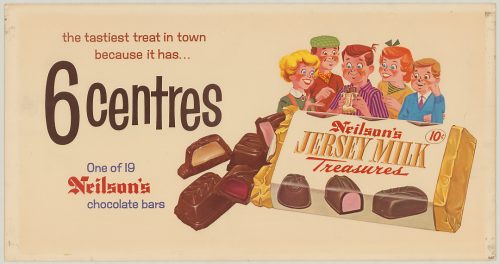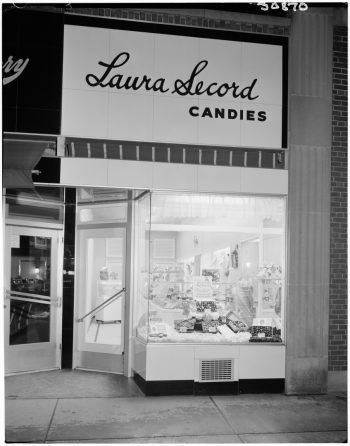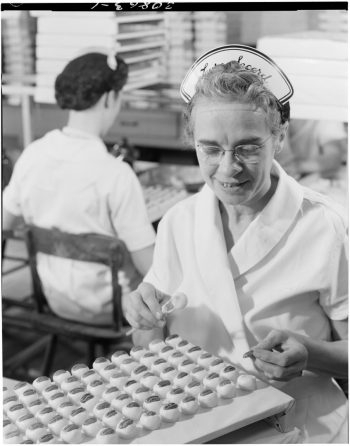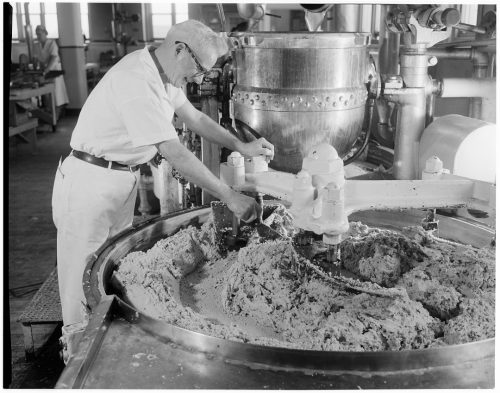
Torontonians have always had a love of sweets. As early as 1834, Toronto had two local confectioners – Alexander Erskine of 65 King Street and Franco Rossi of 217 King Street. A decade later, the number of confectioners had increased to ten. By 1890, the city directory listed more than 150 businesses involved in the production of confectionery and cocoa, the growth of the industry fuelled, in part, by innovations in chocolate-making that created a better tasting product with a smoother texture.
Gradually, Toronto’s small store-front confectioners were supplanted by large-scale manufacturers that distributed their products well beyond the neighbourhoods in which they were made. In the early decades of the 20th century, Toronto’s chocolate industry was characterized by the rise of three big players on the national stage: Neilson’s, Laura Secord, and Willards.
William Neilson (1844-1915), who rose to prominence as an ice cream manufacturer, began producing bulk and boxed chocolate at his Gladstone Avenue plant in 1906 as a way of keeping his skilled ice cream makers employed during the slow winter months. By 1914, Neilson’s was manufacturing over 500,000 lbs of chocolate per year. When Neilson died in 1915, his son Morden took over the family business.
Under Morden’s tenure, Neilson’s would become Canada’s largest chocolate maker, famous for its Crispy Crunch (1923) and Jersey Milk (1924) chocolate bars, products that are still enjoyed today.

In 1913, Frank O’Connor (1885-1939) and his wife Mary (1878-1931) opened their first Laura Secord store at 354 Yonge Street, just north of Elm Street. Selling products manufactured in the kitchen of their upstairs apartment, O’Connor emphasized the quality, purity, and dignity of his chocolates – values that were embodied by the well-known historical figure chosen to be the name and face of the company.

According to O’Connor, the design of the first Laura Secord store on Yonge St. was intended to look “homey.” Painted white with a simple black trim, its windows hung with polka-dot muslin curtains, the store mirrored the design of its early chocolate boxes.

As an employee of Laura Secord, the woman in this photograph would have participated in an employee profit-sharing program. Introduced by owner Frank O’Connor in 1923 on the occasion of the company’s 10th year of operation, the profit-sharing plan is believed to be the first program of its kind within the confectionery industry.
By 1926, Laura Secord had grown into an international chain with 57 stores in Canada and another 19 in the U.S. under the Fanny Farmer brand. O’Connor himself became as celebrated a figure as his company’s namesake. A generous philanthropist and staunch supporter of the Liberal Party, he was appointed to the Senate in 1935; O’Connor Drive is named in his honour.

Laura Secord’s manufacturing facility at Bathurst St. and Wellington St. West, described by the company as its candy-making “studio,” remained in operation until 1972, when production was transferred to a plant at 1500 Birchmount Rd. in Scarborough.
Willards was founded ca. 1914 by E.G. Robinson, a former Neilson’s employee who has been described by one historian as having “a reputation in the candy industry for price cutting and the use of sharp practices to avoid paying his bills.” Willards, which became famous for its Sweet Marie chocolate bar, was also notorious for its role in a 1920s labour dispute known as the Chocolate Case. The company was accused of multiple violations of Ontario’s Minimum Wage Act for falsifying payroll records and underpaying its female employees.
Like other food manufacturing sectors, the confectionery industry experienced numerous mergers and consolidations throughout the 20th century. After the death of Morden Neilson in 1947, George Weston Ltd. purchased Neilson’s. In 1954 they also acquired Willards and the two subsidiaries were merged in 1970. The Neilson brand now forms part of Mondelez International, and its Gladstone Avenue plant manufactures Dairy Milk, Crispy Crunch, and Mr. Big chocolate bars.
Laura Secord has also changed hands many times since its acquisition by its former subsidiary Fanny Farmer in 1967, including ownership by Labatt (1969), Rowntree (1983), and Nestlé (1988). Currently the company is owned by Quebec-based chocolatier Nutriart.